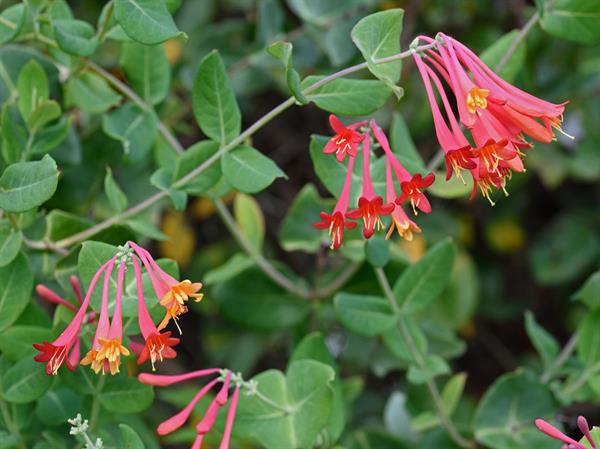
ID notes:Readily distinguished from L. japonica by its glabrous stems (stems sometimes glandular but lacking obvious brown hairs like L. japonica).
Origin/Endemic status: Native
Taxonomy Comments: Var. hirsutula has sometimes been maintained, differing from var. sempervirens in its ciliate leaf margins, pubescent upper leaf surfaces, sometimes glandular hypanthia and stems (vs. glabrous); it is doubtful that these distinctions are taxonomically meaningful.
Synonymy: = Ar, Fl7, GrPl, GW2, Il, K3, K4, Mi, Mo2, NcTx, NY, Pa, RAB, Tat, Tn, Tx, Va, W, WH3, WV, Ferguson (1966a); = Phenianthus sempervirens (L.) Raf. – S; > Lonicera sempervirens L. var. hirsutula – C, F, G, K1, Rehder (1903); > Lonicera sempervirens L. var. minor Aiton – F; > Lonicera sempervirens L. var. sempervirens – C, F, G, K1, NE, Rehder (1903)
Wetland Indicator Status:
- Atlantic and Gulf Coastal Plain: FACU
- Eastern Mountains and Piedmont: FACU
- Great Plains: FAC
- Midwest: FACU
- Northcentral & Northeast: FACU
Heliophily: 6
Hover over a shape, letter, icon, or arrow on the map for definition or see the legend.
 © Gary P. Fleming | Original Image ⭷
© Gary P. Fleming | Original Image ⭷ © Bruce Sorrie | Original Image ⭷
© Bruce Sorrie | Original Image ⭷ © Grant Morrow Parkins | Original Image ⭷
© Grant Morrow Parkins | Original Image ⭷ © Scott Ward | Original Image ⭷
© Scott Ward | Original Image ⭷ © Scott Ward | Original Image ⭷
© Scott Ward | Original Image ⭷ © Gary P. Fleming | Original Image ⭷
© Gary P. Fleming | Original Image ⭷ © Keith Bradley | Original Image ⭷
© Keith Bradley | Original Image ⭷ © Joey Shaw source | Original Image ⭷
© Joey Shaw source | Original Image ⭷ © Rob Gardner | Original Image ⭷
© Rob Gardner | Original Image ⭷ © Alan M. Cressler | Original Image ⭷
© Alan M. Cressler | Original Image ⭷ © Jennifer Peterson | Original Image ⭷
© Jennifer Peterson | Original Image ⭷ © Bruce A. Sorrie | Original Image ⭷
© Bruce A. Sorrie | Original Image ⭷ © Rob Gardner | Original Image ⭷
© Rob Gardner | Original Image ⭷ © Joey Shaw source | Original Image ⭷
© Joey Shaw source | Original Image ⭷Feedback
See something wrong or missing on about Lonicera sempervirens? Let us know here: (Please include your name and email if at all complicated so we can clarify if needed.)
Cite as...